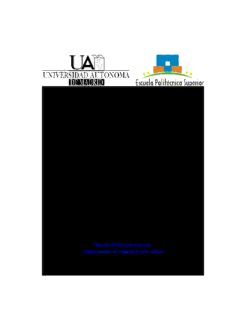
Development of a Multi-UAV Simulator to Analyze the Behavior of Operators in Coastal ... PDF
Preview Development of a Multi-UAV Simulator to Analyze the Behavior of Operators in Coastal ...
Development of a Multi-UAV Simulator to Analyze the Behavior of Operators in Coastal Surveillance Missions Author: V´ıctor Rodr´ıguez Ferna´ndez Advisor: David Camacho Ferna´ndez A thesis submitted in partial fulfillment for the Master Degree on Research and Innovation in Information and Communication Technologies in the Escuela Polit´ecnica Superior Departamento de Ingenier´ıa Informa´tica April 2015 “Ambition is the path to success. Persistence is the vehicle you arrive in.” Bill Bradley Abstract Escuela Polit´ecnica Superior Departamento de Ingenier´ıa Inform´atica Master on Research and Innovation in Information and Communication Technologies by V´ıctor Rodr´ıguez Fern´andez This Master Thesis 1 presents the design and development of a computer simulator created for executing and supervising missions carried out by multiple Unmanned Aerial Vehicles (UAVs). The aim of this simulator is to provide an open, simple and accessible environment to train andanalyzetheperformanceandevolutionoflow-experiencedhumanoperatorssupervisingand controlling a team of UAVs. This work is divided into two parts. The first one is focused on describing the simulator mech- anisms and architecture. To accomplish the required accessibility of this tool for novice users, the simulator has been implemented following a web architecture, where only a web browser is needed to execute it. Also, in order to engage and challenge the operator, some gamification elements have been added, bringing the simulation closer to a videogame experience. The second part of this work uses the developed simulator to carry out several experiments with novice users. A set of performance metrics is designed to define the profile of a user, and basedonthoseprofiles,werunandvalidatesomeclusteringalgorithmstoobtaingroupsofusers with common performance profiles. These results are analyzed to extract behavioral patterns that distinguish and rank the different users in the experiment, allowing the identification and selection of potential expert operators. Keywords Unmanned Aerial Vehicles, Human-Robot Interaction, Computer-based Simulation, HTML5, Web, Videogames, Performance metrics, Clustering, Behavioral patterns 1This work has been funded by Airbus Defence & Space (SAVIER Project: FUAM-076914) Resumen Escuela Polit´ecnica Superior Departamento de Ingenier´ıa Inform´atica M´aster en Investigaci´on e Innovaci´on de las Tecnolog´ıas de la Informaci´on y las Comunicaciones por V´ıctor Rodr´ıguez Fern´andez El presente Trabajo Fin de M´aster 2 presenta el disen˜o y desarrollo de un simulador creado con el fin de ejecutar y supervisar misiones llevadas a cabo por mu´ltiples Veh´ıculos A´ereos no Tripulados(UAVs). Elobjetivodeestesimuladoresofrecerunentornosimpleyaccesibledonde entrenar y analizar el rendimiento y la evoluci´on de operadores inexpertos mientras supervisan y controlan un equipo de UAVs. Este trabajo se divide en dos partes. La primera est´a enfocada en describir el funcionamiento del simulador y su arquitectura. Para lograr la accesibilidad que esta herramienta requiere de cara a usuarios inexpertos, el simulador ha sido implementado siguiendo una arquitectura web, donde s´olamente se requiere un navegador web para ejecutarlo. Adem´as, para atraer y retar al operador, se han introducido algunos elementos de gamificaci´on, que acercan este simulador a una experiencia propia del mundo de los videojuegos. Lasegundapartedeltrabajosebasaenelsimuladordesarrolladoparallevaracabovariosexper- imentosconusuariosinexpertos. Sehadisen˜adounconjuntodem´etricasderendimientoconlas cualessedefineelperfildeunusuario. Usandoestosperfiles,seejecutanyvalidanalgoritmosde clustering para obtener grupos de usuarios con perfiles de rendimiento comunes. Los resultados seanalizandecaraaextraerpatronesdecomportamientoquedistinganalosdiferentesusuarios del experimento, permitiendo la identificaci´on y selecci´on de operadores expertos potenciales. Palabras Clave Sistemas A´ereos no tripulados, Interacci´on humano-robot, Simulaci´on por computadora, HTML5, Web, M´etricas de rendimiento, Clustering, Patrones de comportamiento 2Este trabajo ha sido financiado por Airbus Defence & Space (Proyecto SAVIER: FUAM-076914) Acknowledgements First of all, I would like to acknowledge the financial support given by Airbus Defence & Space under the Savier project (FUAM-076914), as well as all the information and help provided from the Savier Open Innovation Project members: Jos´e Insenser, Juan Antonio Henr´ıquez and Gemma Blasco. Secondly, I would like to thank David Camacho for managing this Master Thesis and giving me the opportunity to work in this research group, and Antonio Gonz´alez Pardo, with whom I hope to develop a long and successful career in the next years. I would like to express my gratitude to all my workmates from the AIDA group, both thosewhoareworkingnowandthosewholeftuslastyear, speciallytoFernandoPalero. I am also indebted to all the people who have accompanied me throughout all these years in the university, specially to Daniel G.V and Diego, who has become my personal psychologist during the coffee time. Special thanks to the three people who have been by my side day after day throughout the course of this Master Thesis: Gema Bello Orgaz, undoubtedly one of the best people I have had the pleasure of meeting this year, H´ector D. Men´endez, who has tutored the whole of this work, and to whom I owe most of what I have learned here, and Cristian Ram´ırezAtencia, whohasbecomeabrothertomeaftermorethan6yearsofcontinuous working, geeking and laughing together. Finally, I would like to express my deepest gratitude to my family, specially to my mother for being so patient and kind with me, and to Reyes S.G, for giving me, even in the distance, the strength to accomplish all my goals and the smile to go through all of them. viii
Description: